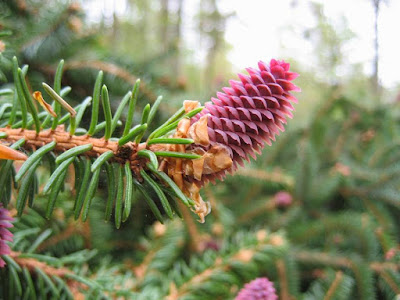Gymnosperms of Laos
The
gymnosperms are a group of seed-producing plants (spermatophytes) that includes
conifers (Pinophyta), cycads, Ginkgo, and gnetophytes. The term
"gymnosperm" comes from the Greek composite word γυμνόσπερμος (γυμνός
gymnos, "naked" and σπέρμα sperma, "seed"), meaning
"naked seeds". The name is based on the unenclosed condition of their
seeds (called ovules in their unfertilized state). The non-encased condition of
their seeds stands in contrast to the seeds and ovules of flowering plants (angiosperms),
which are enclosed within an ovary. Gymnosperm seeds develop either on the
surface of scales or leaves, which are often modified to form cones, or solitary
as in Yew, Torreya, Ginkgo.
The
gymnosperms and angiosperms together compose the spermatophytes or seed plants.
The gymnosperms are divided into six phyla. Organisms that belong to the
Cycadophyta, Ginkgophyta, Gnetophyta, and Pinophyta (also known as
Coniferophyta) phyla are still in existence while those in the Pteridospermales
and Cordaitales phyla are now extinct.
By
far the largest group of living gymnosperms are the conifers (pines, cypresses,
and relatives), followed by cycads, gnetophytes (Gnetum, Ephedra and
Welwitschia), and Ginkgo biloba (a single living species).
The present review includes keys for identification and summary data on
the nomenclature, morphology, ecology and distribution for all 33
species of gymnosperms hitherto recorded in the flora of Laos. They
belong to 8 families and 15 genera. Important additions to these data
were obtained during fieldwork in 2009-2013, when 58 localities
containing 25 species from 14 genera and 8 families were explored and
initially studied. Two species, Cycas laotica and Pinus cernua, are
described as new species for science. Seven species, Cycas
dolichophylla, C. inermis, C. macrocarpa, C. micholitzii, C.
nongnoochiae, C. petraea and Taxus wallichiana, are found in Laos and
represent new records for the flora of the country. Maps of the
distribution and illustrations for the newly discovered gymnosperm
species are provided. All observations, records and discoveries are
based on reliable scientific literature and collected voucher herbarium
specimens housed in main regional herbaria.



Nhận xét
Đăng nhận xét